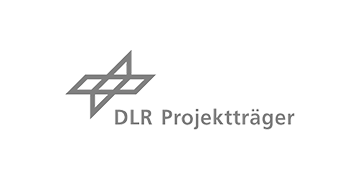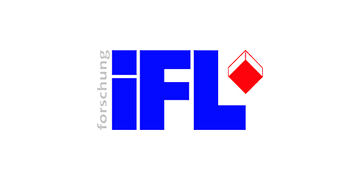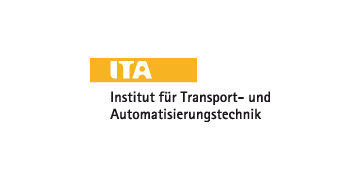| Theme | Industry 4.0, Automated guided vehicles |
|---|---|
| Project title | Virtual vision enhancement and intuitive interaction through Augmented Reality on industrial trucks (ViSIER) |
| Project duration | 01.06.2019 – 30.11.2021 |
| Video | |
| Download | |
| Press release |
One of the biggest challenges when operating a forklift truck is the driver's limited view of his surroundings, especially when storing and retrieving load carriers or transporting bulky loads. Different camera and assistance systems are used on the vehicles to support the driver and his environment and increase the operational safety of the vehicle. Controls and screens for displaying order data, vehicle parameters or the playback of rear view or fork arms cameras, as used today in most vehicles, also represent an additional visual restriction.
The aim of this research project is to implement an AR-based operator assistance system for forklift trucks, with the support of which visual restrictions of the driver, caused by vehicle components and load, are compensated and vehicle and order data are networked with the driver depending on the situation. The interaction with the assistance system is to take place via gestures and virtual elements.
- Sorry, no events available.
Vergangene Termine gefunden
- 27.08.2019, 10:30 h - 14:45 h
- IPH - Institut für Integrierte Produktion Hannover gGmbH, Hollerithallee 6, 30419 Hannover
- 23.04.2020, 10:30 h - 12:30 h
- IPH Hannover gGmbH | Hollerithallee 6 | 30419 Hannover
- Online meeting via MS Teams
- 11.11.2020, 10:00 h - 12:00 h
- IPH Hannover gGmbH | Hollerithallee 6 | 30419 Hannover
- Online meeting via MS Teams
- 26.11.2021, 11:00 h - 13:00 h
- Institut für Transport- und Automatisierungstechnik | An der Universität 2 | 30823 Garbsen
- Online meeting (Webex)
Publications about the project
Purpose: The paper aims to explore the use of an augmented reality assistance system to enhance safety in forklift operations by addressing visibility challenges caused by structural and load-induced obstructions. A user study validates the potential of see-through as a driver assistance system on forklifts, and highlights challenges in accuracy, latency and image quality.
Design/methodology/approach: The paper opted for a comprehensive user study with 18 participants. The tests were conducted while the forklift was not driving. Participants were allowed to elevate and incline the mast to evaluate the system’s performance. All participants answered 11 questions focusing on performance, usability and optimization. The questionnaire used an 11-point Likert scale (0: strongly disagree, 10: strongly agree) to quantify the personal opinions of the users. Depending on the hypotheses, one-sample or two-sample t-tests were carried out to evaluate the questionnaires.
Findings: The paper provides insight into the evaluation of an augmented reality-based driver assistance system for forklifts. The study identified latency and image quality as critical areas for improvement, essential for enhancing user acceptance and operational reliability.
Research limitations/implications:
Because of the restriction of the participants to a university environment and the fact that the user study was carried out while the vehicle was not driving, the research results may lack industrial transferability. For this reason, researchers should carry out further investigations in companies, for which considerable safety precautions are necessary.
Originality/value: This paper fulfills an identified need to study how the visibility problem on forklifts can be solved and thus increase safety in intralogistics.
ehicle safety, advanced driver assistance systems, imaging, augmented reality
Limited visibility during the operation of forklifts is one of the most significant sources of danger in in-plant material handling. Existing systems record concealed areas via cameras and display them directly on monitors in the operator's cab. The operator has to temporarily turn his attention to a screen and is unable to perceive the real information necessary for the driving task. We developed the first augmented reality based driver assistance system for safety improvement in intralogistics. The results show the capability to eliminate view restrictions directly in the operator's field of view and create the illusion of transparent vehicle components.
augmented reality, assistance system, intralogistics
The temporally and spatially accurate display of information in augmented reality (AR) systems is essential for immersion and operational reliability when using the technology. We developed an assistant system using a head-mounted display (HMD) to hide visual restrictions on forklifts. We propose a method to evaluate the accuracy and latency of AR systems using HMD. For measuring accuracy, we compare the deviation between real and virtual markers. For latency measurement, we count the frame difference between real and virtual events. We present the influence of different system parameters and dynamics on latency and overlay accuracy.
augmented reality, image processing, driver assistance system, forklift trucks
This article presents a method for superimposing vision constraints based on the principle of augmented reality. The method is based on an overlay of the actual operator's field of view with information from a reconstructed scene. The reconstructed scene is superimposed as a hologram only over the vision-restricting components. The presented method is divided into position determination, data transmission and visualization. These software components are presented in detail. In view of the later use of the system in an industrial truck, the real-time capability of the data transmission, the accuracy of the visualization and the robustness of the position determination are also investigated.
augmented reality, driver assistance system, forklift trucks, image processing, obstacle detection
How to compensate the restricted vision in forklifts with the help of strategically placed cameras and augmented reality glasses? Scientists from ITA and IPH are jointly tackling this question.
Augmented reality, AR, industrial trucks, vision enhancement, assistance system
In this article, a method for automatic visual obstruction detection and masktype congruent visual obstruction compensation, based on the principal of augmented reality, is presented. The method is based on the superposition of a simulated operator’s field of view with information from a scene reconstructed by two RGB-Cameras. These cameras are arranged in a way that they can record the scene information be-hind the view restriction. Besides the presentation of the test rig, a detailed presentation of the image pro-cessing software is given. With a view to the later use of the system in a forklift truck, the real-time capa-bility of the system will be tested and optimization possibilities will be discussed.
augmented reality, driver assistance system, forklift trucks, image processing, obstacle detection
Due to their design, the lift mast and attachments on industrial trucks, among other things, can restrict the operator's field of vision. In the project "Virtual visibility improvement and intuitive interaction through augmented reality on industrial trucks (Visier)", this situation is to be counteracted with the development of a new driver assistance system. With the aid of augmented reality (AR) goggles, the aim is to create the conditions for the driver to be able to block out visual restrictions and thus take a look behind the cargo and the mast in order to detect hazards and obstacles at an early stage.
Augmented Reality, assistance system, industrial trucks















